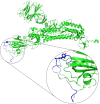Identification of a Potential mRNA-based Vaccine Candidate against the SARS-CoV-2 Spike Glycoprotein: A Reverse Vaccinology Approach
- PMID: 35601809
- PMCID: PMC9111088
- DOI: 10.1002/slct.202103903
Identification of a Potential mRNA-based Vaccine Candidate against the SARS-CoV-2 Spike Glycoprotein: A Reverse Vaccinology Approach
Abstract
The emergence of the novel coronavirus (SARS-CoV-2) in December 2019 has generated a devastating global consequence which makes the development of a rapidly deployable, effective and safe vaccine candidate an imminent global health priority. The design of most vaccine candidates has been directed at the induction of antibody responses against the trimeric spike glycoprotein of SARS-CoV-2, a class I fusion protein that aids ACE2 (angiotensin-converting enzyme 2) receptor binding. A variety of formulations and vaccinology approaches are being pursued for targeting the spike glycoprotein, including simian and human replication-defective adenoviral vaccines, subunit protein vaccines, nucleic acid vaccines and whole-inactivated SARS-CoV-2. Here, we directed a reverse vaccinology approach towards the design of a nucleic acid (mRNA-based) vaccine candidate. The "YLQPRTFLL" peptide sequence (position 269-277) which was predicted to be a B cell epitope and likewise a strong binder of the HLA*A-0201 was selected for the design of the vaccine candidate, having satisfied series of antigenicity assessments. Through the codon optimization protocol, the nucleotide sequence for the vaccine candidate design was generated and targeted at the human toll-like receptor 7 (TLR7). Bioinformatics analyses showed that the sequence "UACCUGCAGCCGCGUACCUUCCUGCUG" exhibited a strong affinity and likewise was bound to a stable cavity in the TLR7 pocket. This study is therefore expected to contribute to the research efforts directed at securing definitive preventive measures against the SARS-CoV-2 infection.
Keywords: Antigens; Reverse vaccinology; SAR-CoV-2; Spike glycoprotein; Vaccine; Viruses.
© 2022 Wiley‐VCH GmbH.
Conflict of interest statement
The authors declare no conflict of interest.
Figures
















Similar articles
-
Advances of Reverse Vaccinology for mRNA Vaccine Design against SARS-CoV-2: A Review of Methods and Tools.Viruses. 2023 Oct 21;15(10):2130. doi: 10.3390/v15102130. Viruses. 2023. PMID: 37896907 Free PMC article. Review.
-
Reverse vaccinology assisted designing of multiepitope-based subunit vaccine against SARS-CoV-2.Infect Dis Poverty. 2020 Sep 16;9(1):132. doi: 10.1186/s40249-020-00752-w. Infect Dis Poverty. 2020. PMID: 32938504 Free PMC article.
-
A reverse vaccinology and immunoinformatics approach for designing a multiepitope vaccine against SARS-CoV-2.Immunogenetics. 2021 Dec;73(6):459-477. doi: 10.1007/s00251-021-01228-3. Epub 2021 Sep 20. Immunogenetics. 2021. PMID: 34542663 Free PMC article.
-
Identification of Potential Vaccine Candidates Against SARS-CoV-2 to Fight COVID-19: Reverse Vaccinology Approach.JMIR Bioinform Biotechnol. 2022 Apr 26;3(1):e32401. doi: 10.2196/32401. eCollection 2022 Jan-Dec. JMIR Bioinform Biotechnol. 2022. PMID: 35506029 Free PMC article.
-
COVID-19 Coronavirus Vaccine Design Using Reverse Vaccinology and Machine Learning.Front Immunol. 2020 Jul 3;11:1581. doi: 10.3389/fimmu.2020.01581. eCollection 2020. Front Immunol. 2020. PMID: 32719684 Free PMC article.
Cited by
-
MasitinibL shows promise as a drug-like analog of masitinib that elicits comparable SARS-Cov-2 3CLpro inhibition with low kinase preference.Sci Rep. 2023 Apr 28;13(1):6972. doi: 10.1038/s41598-023-33024-2. Sci Rep. 2023. PMID: 37117213 Free PMC article.
-
Design of a Multiepitope Pan-Proteomic mRNA Vaccine Construct Against African Swine Fever Virus: A Reverse Vaccinology Approach.Vet Med Int. 2025 Jan 4;2025:2638167. doi: 10.1155/vmi/2638167. eCollection 2025. Vet Med Int. 2025. PMID: 39803351 Free PMC article.
-
Advances of Reverse Vaccinology for mRNA Vaccine Design against SARS-CoV-2: A Review of Methods and Tools.Viruses. 2023 Oct 21;15(10):2130. doi: 10.3390/v15102130. Viruses. 2023. PMID: 37896907 Free PMC article. Review.
-
Immunology to Immunotherapeutics of SARS-CoV-2: Identification of Immunogenic Epitopes for Vaccine Development.Curr Microbiol. 2022 Sep 5;79(10):306. doi: 10.1007/s00284-022-03003-3. Curr Microbiol. 2022. PMID: 36064873 Free PMC article. Review.
-
The Advantage of Using Immunoinformatic Tools on Vaccine Design and Development for Coronavirus.Vaccines (Basel). 2022 Oct 31;10(11):1844. doi: 10.3390/vaccines10111844. Vaccines (Basel). 2022. PMID: 36366353 Free PMC article. Review.
References
-
- Drosten C., Günther S., Preiser W., Van Der Werf S., Brodt H.-R., Becker S., Rabenau H., Panning M., Kolesnikova L., Fouchier R. A., N. Engl. J. Med. 2003, 348 (20), 1967. - PubMed
-
- Zaki A. M., Van Boheemen S., Bestebroer T. M., Osterhaus A. D., Fouchier R. A., N. Engl. J. Med. 2012, 367 (19), 1814. - PubMed
LinkOut - more resources
Full Text Sources
Research Materials
Miscellaneous
